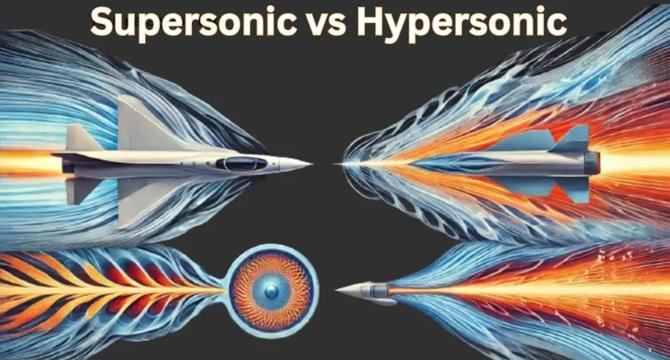Scientificworldinfo
1M
369

Image Credit: Scientificworldinfo
What is the Difference Between Supersonic and Hypersonic Flow?
- This article provides an in-depth comparison between supersonic and hypersonic flow, that discusses shock waves, aerodynamic heating, viscous effects, chemical non-equilibrium, and the implications for aircraft design and propulsion.
- Supersonic flow is defined as flow in which the free-stream Mach number, MMM, exceeds 1. In comparison, hypersonic flow is generally defined as flow with a Mach number greater than 5, as speeds continue to increase and surpass approximately Mach 5.
- Supersonic aircraft typically have thin, highly swept wings to minimize drag and control shock wave interactions. For example, military fighters and the Concorde operate in this regime, usually between Mach 1 and about Mach 3–5. On the other hand, hypersonic vehicles require advanced high-temperature materials, including ceramics, refractory alloys, or specialized composite materials.
- Hypersonic vehicles often rely on scramjet engines (supersonic combustion ramjets) that can operate in extremely high-speed regimes while supersonic aircraft typically use turbojets or low-bypass turbofans with afterburners
- Although supersonic and hypersonic flows occur at speeds exceeding the speed of sound, they differ in several critical ways: Speed Thresholds, Shock Wave Characteristics, Aerodynamic Heating, Chemical Nonequilibrium, Material and Structural Demands, Propulsion Requirements, and Aerodynamic Control.
- In supersonic flow, shock waves are prominent and dictate aerodynamic performance. In hypersonic flow, shocks are much stronger and closer to the body, resulting in thinner shock layers.
- Propulsion systems for hypersonic flight (e.g., scramjets) are fundamentally different from those used in supersonic aircraft (e.g., turbojets with afterburners) due to the distinct flow characteristics and thermal loads.
- Control surfaces and overall vehicle stability become more complex as speed increases, while the thermal loads in hypersonic flight are orders of magnitude higher than that of supersonic flight.
- Despite the differences, the understanding of both these flows is fundamental from a scientific standpoint and crucial for military defense systems, space re-entry vehicles, and commercial high-speed travel.
- As researchers continue to push the envelope of high-speed flight, the differences between these regimes drive the development of new materials, propulsion systems, and design strategies.
Read Full Article
22 Likes
For uninterrupted reading, download the app